


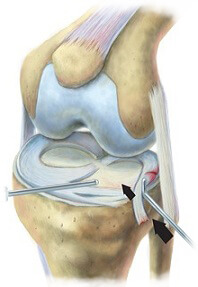
Improve surgical outcomes with home medical devices.
(Or avoid surgery altogether!)
You simply need to use the right post surgical treatment.
Meniscus "Repair" Surgery involves cutting away torn sections of the Meniscus. The name is very misleading. The procedure usually gets rid of the pain by getting rid of the tissue, instead of fixing the actual problem. Meniscus Surgery should really be a last resort.
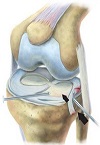
That pretty picture at the top of the page is a typical representation of your knee that you will find online. It is very common for websites to make it look like the meniscus is a flat piece of tissue that is easily accessible between the bones of your knee. But that is a sad and misleading misrepresentation. That's an illustration that is intended to make it look like your knee is operable and a surgeon can go in and fix your meniscus tear. But it's not like that at all.
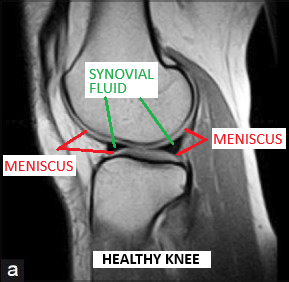
The meniscus is cartilage that grows all over the ends of both your knee bones. It's attached to your bones. That cartilage is very tough, and very slippery. It's purpose is to act as a bump pad and a wear pad and a slippery surface.
Also in that space is a bunch of thick liquid called 'synovial fluid'. Your body produces it to do what blood does in the rest of your body, it brings nutrients to the meniscus and clears away the waste. Synovial fluid is also a lubricant. That cavity between your bones is packed tight with synovial fluid so it also acts as a liquid buffer pushing the bones apart.
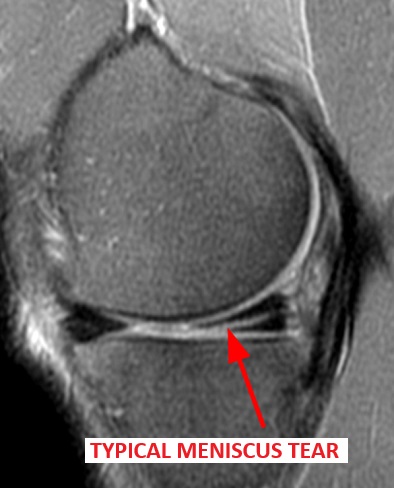
Surrounding the knee is a ton of tough, tough tissue forming the synovial cavity that holds everything in place. Then there are ligaments and tendons that are strong, unyielding ropes that would never allow your joint to have the bones pulled apart so a doctor can get access to do surgery. Even if they could get access, the forces are so strong in the knee that when you move, stitches would get ripped apart right away. The reality is, a surgeon can't repair your meniscus. At best, they can only cut the broken pieces away.
Consider the MRI pictures shown. This is what your knee really looks like inside. In the healthy picture you can see the meniscus on both bones and the synovial fluid in between.
In the MRI photo showing a torn meniscus you can see the tear is really a tiny little piece of tissue torn. That tiny tear is what can cause you an incredible amount of pain! If you go in for surgery, the doctor is just going to cut that little piece away and it will never grow back.
If, on the other hand, you do what is required to let it heal, your body will reattach that meniscus to the rest over time. It will take months for your body to repair that kind of injury, but your body will do it if you let it. It may look small, but every bit of meniscus is hugely important to your knee being healthy. For the details on how your body makes that repair, see our wound healing page.

A chiropractor usually recommends chiropractic adjustments, because that's what they do to solve problems. A Naturopath recommends herbs and supplements, because that's what they do to solve problems. A religious leader recommends prayer, because that's what they do. If you go see an acupuncturist about your knee, you know what they will recommend. Every professional has a deep sense of commitment to their trade. A surgeon is no different. Surgery is what they do.
What's more though, is that you've gone to the doctor complaining about the pain in your knee. If it didn't hurt you would never have pursued the matter. If the doctor cuts away your torn meniscus, that problem is gone. If there are no complications, 6 weeks later you will feel much better. To the surgeon, he/she is giving you exactly what you came for - immediate relief from the pain.
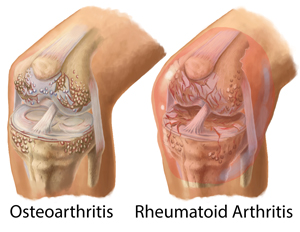
The issue with meniscus removal is that then you have that much less protection in your knee, and it is only a matter of time before another knee injury arises. Your likelihood of arthritis also increases significantly. You can probably go for 2 or 3 'repair' procedures over the course of 10 or 12 years. After that, the surgeon will tell you there's not enough meniscus left and that you need a full knee replacement.
If there are no side effects or complications, surgery will often work in the short term. But there can be complications. And there can be lasting effects. And you are absolutely heading down the path to eventual knee replacement. To the surgeon, that's the right path to go. Surgery is what surgeons have to offer.
There's no doubt about it, letting it heal takes time. Maybe you just have a tiny tear and it's annoying at the best of times and a painful nuisance from time to time. People in that category can baby their knee for a month then slowly reintroduce more activity. Often within 6 months they are largely back to normal.
For a lot of people, the current situation is largely debilitating. For a lot of people there is very little activity they can do anymore, and they have been waiting for months already for the injury to heal on it's own. In most cases, these people have been doing as much as the pain will allow.
They've gone to physiotherapy and tried to do the stretching and exercises, but they didn't realize they were doing them too early in the recovery process. Physio has it's place, but it's later in recovery, after the injury has stabilized and begun to heal.
For this group to heal, they need to quit driving through pain, quit with the pain killers, grab some crutches or a cane, and really take it easy. There are conservative techniques such as BFST available to speed the healing, but this needs to be done in conjunction with significant rest for the injury. With proper treatment, this group are likely to heal more slowly, getting back to normal in about 1 year. Full recovery can take up to 2 years but the 2nd year is largely being careful and not truly limiting.
Some people have very significant damage in their knee. Even the worst situations can heal, though, if they are given the time and proper care. Preventing reinjury is the biggest issue in this group. Almost everything they do aggravates the condition. Every day the meniscus heals a tiny bit and every day they do something to reinjure their knee. It becomes a case of one step forward and two steps backward. For this group the focus needs to be on limiting the backward steps. They also need to make the steps forward as large as possible using supplemental treatments. Fortunately, even the worst meniscus tears can heal if you take care of them adequately over a long enough time.

The human body has an incredible ability to heal itself. Whether you do everything right and are returning to normal in a few weeks or if you struggle and it takes several months, your body will keep trying to heal. And long after the pain is gone and your body feels normal, your body will still be healing the injury. In many cases with cartilage and ligament damage, the body can still be repairing the tissue 2 years later, even though you had long forgotten about the injury.
For the details on how your body heals over time, see our wound healing page.
The reality of a meniscus injury is that it is usually several months before the pain is gone and you resume normal life. But if you take proper care of yourself and let it heal properly, you are likely to never be plagued by the injury again. If you really care for it well it can heal decently quickly. If you have a lot of bad habits and drive through the pain, it may plague you continuously. If you opt for surgery, on the other hand, you are entirely likely to be facing more knee issues and more surgeries for the next 10 to 20 years.
Surgery is a trade-off. Surgery is short term relief in exchange for long term struggles.
The Meniscus is living tissue that can heal. Trying to heal it quickly before it tears again is the big challenge. Don't allow your Meniscus to be cut away forever by "repair surgery". Use King Brand's® ColdCure® and BFST® Knee Wraps to heal quickly and completely.
Start with the ColdCure® Knee Wrap to reduce your pain and swelling. When the swelling and inflammation is gone, start doing BFST® treatments. The BFST® Knee Wrap will stimulate blood flow in your knee to accelerate the healing of your Meniscus.
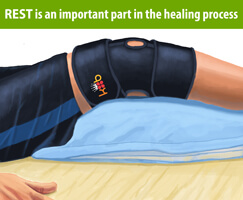
Rest is also important if you want to avoid surgery and heal properly. Avoid any activities that could further aggravate your Meniscus injury. Stop doing the activity that caused your injury. Try to rest your knee as much as possible. Using crutches will help you stay off your knee to prevent re-injury.
Knowing what not to do can be a challenge. Often people don't realize the things that they are doing that are reinjuring their meniscus. Isometric strain is one of the biggest reasons people have difficulty healing knee injuries. For more information on things that can make your condition worse, check out our causes of meniscus reinjury page.
Do this and your Meniscus injury can truly heal - Finally.
Should you opt to go forward with surgery, be aware that while it may be the quick fix you were looking for, you will not be healthy immediately after the surgery is complete. The removal or repair of the damaged area will be painful following the operation. Also, the tissue will not be fully healed, and will require a period of healing afterwards.
If surgery is your only option, King Brand products can aid in your recovery. Our Knee ColdCure® Wrap will help reduce your pain and swelling following surgery. When the swelling and inflammation is gone, use our Knee BFST® Wrap to help increase blood flow to the Meniscus and speed up your recovery time.
You don't have to wait for endless months in pain. You can heal your Meniscus much more quickly with the right treatment. For a Meniscus injury, blood flow is the most critical element in rapid recovery. Blood Flow Stimulation Therapy™ (BFST®) gives your Meniscus the blood flow it needs to heal quickly and completely.
BFST® brings oxygen and nutrient-rich blood to the injured Meniscus - a requirement for the body to heal itself. Unfortunately, an injured Meniscus at rest often has restricted blood flow. Physical activity will promote blood flow but all too often it also results in small but frequent re-injury, which extends your healing time and greatly increases the amount of scar tissue that develops. With a King Brand® BFST® Knee Wrap, blood flow can be stimulated in your Meniscus while you're at rest. With improved blood flow and without physical activity and the risk of re-injury, you can recover from your Meniscus injury or surgery at a surprisingly rapid rate.
For more information on solutions to accelerate your healing, check out our advanced treatment of meniscus injury page.
Professional athletes are the best example of how quickly people can really recover from Meniscus injuries. When a professional athlete injures their Meniscus, they have explicit instructions to stay off their injured knee - no physical activity, no weight on the knee, crutches - they are ordered to rest the knee completely. Injured professional athletes are also attended to by professional athletic therapists. These pro therapists have always been assigned to the athlete to ensure they supplement the healing process, to stimulate blood flow many times each day. Regular BFST® treatments are a standard part of that therapy because the more we promote blood flow, the faster we will heal. That's why professional athletes are back in the game in days, while regular patients with the same injuries often take weeks or even months to heal. With the addition of BFST®, pro athletes and others who use it are recovering from their Meniscus injuries and surgeries faster than ever.
Painkillers mask the pain and cause you to continue to injure your Meniscus. This only makes things worse. It is understandable that people need relief from the pain, so if you have to take painkillers, try to restrict them to times when you are off your knee. You can use painkillers to help you sleep. Using them when you are active is a recipe for permanent damage.
The safest and most effective pain reliever is a ColdCure® Knee Wrap from King Brand®. The ColdCure® Knee Wrap is specifically designed to treat the pain associated with Meniscus injuries and Meniscus surgery. They do a superior job of relieving swelling and inflammation. This innovative device is incredibly soothing and protects your Meniscus from further injury. The pain killing element is actually very powerful and it works instantly - there's no 20 minute wait like with pills.

Meniscus injuries are extremely painful and debilitating. Analgesics such as ASA or acetaminophen are often used to treat the pain, but these drugs do nothing to treat the actual condition. In fact, pain killers are known blood thinners and actually make the bleeding worse for fresh tissue injuries. Typical pain medications actually interfere with the healing process. Cortisone injections are used in extreme cases but these too are intended to address the pain. They do not promote healing of the injury and they put you at a very high risk of further injury.
For more information on solutions to accelerate your healing, check out our advanced treatment of meniscus injury page.